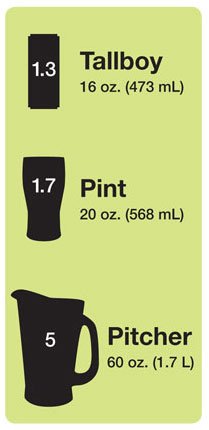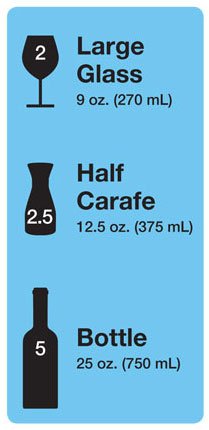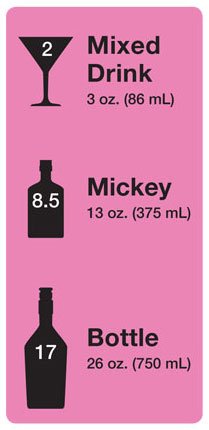Alcohol

Alcohol is a highly popular legal drug. However, many people regularly drink at levels that put their health at risk.
If you choose to drink you can lower your health risks by following Canada's Guidance on Alcohol and Health.
| Guidance on Alcohol and Health |
|
In January 2023, the Guidance on Alcohol and Health was released by the Canadian Centre on Substance Use & Addiction. The new guidance helps people make informed choices about their own health and alcohol consumption. One of the main messages is: If you drink alcohol, it’s better to drink less. Learn about the key messages. |
Drinking alcohol, even in small amounts, is damaging to your health and can increase health risks, including seven types of cancer, most types of cardiovascular diseases, liver disease and violence.
There is a clear continuum of risk associated with average weekly alcohol consumption, where the risk of harm from alcohol is:
• Low for individuals who consume two standard drinks or fewer per week;
• Moderate for those who consume between three and six standard drinks per week; and
• Very high for those who consume seven standard drinks or more per week.
Remember, any reduction in your alcohol use is beneficial. Count your drinks and try to limit yourself to no more than two standard drinks per occasion to reduce the risk of injuries and harm to yourself and others.
When pregnant or trying to get pregnant, zero is best as there is no known safe amount of alcohol use.
When breastfeeding, not drinking alcohol is safest.
Alcohol health risks
| Short-term health effects |
|
May include an increased risk of injury from:
|
| Long-term health effects |
|
If you choose to drink you can lower your health risks by following Canada's Guidance on Alcohol and Health.
To help track how much you are drinking, see Knowing Your Limits With Alcohol - A Practical Guide to Assessing Your Drinking.
If you need help, view the list of substance use health and harm reduction services based in the KFL&A area on our Mental health services page.
![]()
12 oz. (341 mL)
of 5% alcohol beer,
cider or cooler
![]()
5 oz. (142 mL)
of 12% alcohol
wine
![]()
1.5 oz. (43 mL)
of 40% liquor
What is a standard drink?
| What is a standard drink (transcript) |
Video descriptionThe video host walks through outdoor market holding a tray with three drinks on it.HostToday I’m in market square, challenging people to see if they know what is in a standard sized drink. Let’s see how they pour.Video description“What is a standard drink?” Text accompanied by a green icon representing a beer, a blue icon representing a glass of wine and a pink icon representing a mixed drink.Host stands in outdoor market, with a man and a woman. He points at objects off camera. HostIf you were to have a drink, would you be going with wine, or a beer, or a mixed drink?ManI’d go for a mixed drinkHostA mixed drink, ok how about you?WomanProbably a beerHostPour me what you think to be a standard beer.Video descriptionSeveral close up clips of liquid being poured from a clear plastic pitcher into a beer glass.Host is standing at a table with liquids in bottles and clear plastic pitchers, and drink glasses, beer glasses, and wine glasses. People pour the liquids from the bottles and pitchers into the glasses. Host talks to some of the people as they pour. A woman says, “that’s a German sized pour!” host laughs. Man in grey t-shirt pours liquid into a beer glass. HostWow, okay, ya, ambitious, Okay, I like that. Let’s see how that compares to a standard sized beer.Video descriptionClose up of a standard-size beer in glass, next to the glass poured by the man in grey t-shirt.HostSo you’re actually, you got a couple of extra ounces in there.Video descriptionWoman pours red liquid from bottle into wine glassSeveral close up clips of liquid being poured from bottle into wine glass HostI’m going to get you to pour one glass of red.WomanOh, look at that colour!Video descriptionHost compares woman’s glass to a standard sized glass of wineHostLet’s see how you stack up here. So this is a standard glass of wine which is five ounces.Video descriptionClose up of two full beer glasses on table, one beer glass has a label that reads “standard drink.” Transitions to close up of a tray on a table with two drinks containing clear liquid and ice. Next to the tray is a bottle with clear liquid in it. Cut to host standing next to the table with the man and woman.HostWe know that a standard beer is 12 ounces. A standard mixed drink would have 1.5 ounces of liquor.Several clips of people looking closely at two glasses on the tray, while host points at each one and asks “which one of these drinks has 1.5 ounces of liquor and which one has three ounces?” Clips of people answering as they look at the drinks. Man in black t-shirtOh it would be impossible to tell, you’d have to see them make itMan with dark hairYou can’tMan in grey t-shirtI don’t think I can tell, they are they exact sameVideo descriptionMan with glasses is shown on screen standing and listening. Man with blue checkered shirt asks “Why do you think it would be important to know what is a standard sized drink?” A man with a beard answers.Man with beardWell if they are consuming and know that they want to be drinking back just one beer or they want to have a couple of beers, in this event here, they’d be thinking “oh I had two beers,” but in fact they might have had almost four.Video descriptionCut to host standing in front of camera.HostPeople who drink often overpour, and sometimes when you go to the restaurant or bar, serving sizes are actually larger than you think.Words on screenStandard size your drink!One standard drink of alcohol in Canada is: 12 oz. 341 ml. 5% alcohol beer cider cooler 5 oz. 142 mL 12% alcohol wine 1.5 oz. 43 mL 40% alcohol liquor. |
How many standard drinks have you really had?
Serving sizes may be larger than you think. Check your pour. Know how much is in your drink.



Alcohol poisoning
Alcohol poisoning is a serious problem that can occur when someone drinks too much alcohol too fast. Alcohol is metabolized by the liver, but it takes time! It can take your body over an hour to process (metabolize) one standard drink.
Signs of alcohol poisoning include:
- unconsciousness and cannot be awakened
- breathing slowly or irregularly - less than eight breaths per minute, or a gap of more than 10 seconds between breaths
- cool, clammy, pale, or bluish skin
- seizures
- vomiting while sleeping
If you suspect someone has alcohol poisoning:
1. Call 911.
2. Put the person in the recovery position.
3. Do not leave the person alone until help arrives.
Recovery position
If someone passes out from drinking alcohol, you can help reduce the risk of choking by moving them into the recovery position:
1. Raise the person's arm closest to you straight above the head. Straighten the leg closest to you. Bend the other leg at the knee and bring the other arm across the chest.
2. Gently roll the person towards you, guarding their head from injury.
3. Tilt the head to maintain airway. Tuck the nearest hand under the cheek to maintain head tilt.










